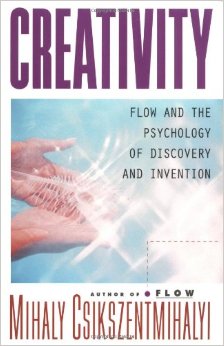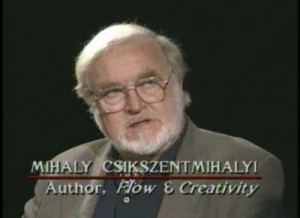 Last year, the Hub reviewed a classic (i.e. not recent) book called Flow, written by a University of Chicago professor, Mihaly Czikszentmihalyi. This time, we’re going to take a look at the same author’s followup book, Creativity, which bears the subtitle Flow and the Psychology of Discovery and Invention.
Last year, the Hub reviewed a classic (i.e. not recent) book called Flow, written by a University of Chicago professor, Mihaly Czikszentmihalyi. This time, we’re going to take a look at the same author’s followup book, Creativity, which bears the subtitle Flow and the Psychology of Discovery and Invention.
It’s a fascinating read for anyone who has fancied themselves an “artiste” or musician, but were never able to extract a living from their creativity. But of course, one bonus of achieving financial independence is that it’s never too late to cultivate one’s creativity. One of the author’s concluding points is that we should strive in various ways to boost our creativity, whether or not it leads to the world’s recognition of our talents. The concluding words are these:
“… what really matters, in the last account, is not whether your name has been attached to a recognized discovery, but whether you have lived a full and creative life.”
Much depends on what “domain” one chooses: there is a chapter on the domain of words: for writers, poets, novelists and those who are “vendors of words,” to use an expression often used by the British journalist and author Malcolm Muggeridge (with whom I was acquainted in 1978-1979 at the University of Western Ontario Journalism School).

Other domains are music, visual arts and life sciences: Czikszentmihalyi devotes entire chapters to biographical surveys of cultural figures who achieved prominence in such domains.
Compared to the original Flow, and with the exception of one chapter devoted to it, there’s not all that much about Flow in this followup work. it is however packed with research and biographical interviews. My edition is a whopping 372 pages, or 456 if you count all the end material.
“Domains” of Creativity
The book is organized in three main sections: The Creative Process, The Lives (which looks at the early and later years of artists as well as Creative Aging), and finally the Domains of Creativity. It concludes with a useful chapter of tips on how we can all boost our personal creativity.
Some of the creative artists interviewed include actor Edward Asner, Canadian novelist Robertson Davies, Canadian jazz pianist Oscar Peterson, biologist/author Barry Commoner, Motorola CEO Robert Galvin, economist Hazel Henderson, chemist Linus Pauling, biologist Jonas Salk, musician Ravi Shankar, Canadian cinematographer Michael Snow, author Benjamin Spock and many more.
All in all, an interesting book on the Creative Process, whether you’re still a young person searching for a domain to master, or semi-retired elders who suppressed their muse in order to make a living and raise families but envisage some sort of creative “Second Act.”
There’s much interesting material on the circumstances that nurture creative artists: the influence on one’s parents, finding a mentor early in one’s academic or work career, getting past the “gatekeepers” of modern culture so that one is recognized and can earn a living from one’s creative efforts.
Luck, talent, persistence all needed
The author doesn’t downplay the difficulty of this winnowing process. Those who make it tend to have drive, focus and perseverance. They often need supportive partners and sometimes just plain luck in being at the right place at the right time. Thus, on page 186:
“Entering a career requires a great deal of determination and a good dose of luck. In fact, the majority of the people we interviewed mentioned luck most frequently as the reason they had been successful.”
Many creative careers turn out not to be “careers” in the ordinary sense of the term: “Creative individuals usually are forced to invent the jobs they will be doing all through their lives.”
Hope for Late Bloomers
As for creative aging and late-bloomer would-be artists, the book is encouraging. “Recent studies suggest that not only quantity but quality is retained with age, and some of the most memorable work in a person’s career is done in the later years.” (Cited as examples are Verdi, Benjamin Franklin and Frank Lloyd Wright, who accomplished significant things at age 80, 78 and 91 respectively.)
Virtually all the older creative artists featured in the book view age positively and all are “still deeply involved in tasks that are exciting and rewarding, even if they are ultimately unattainable.”

